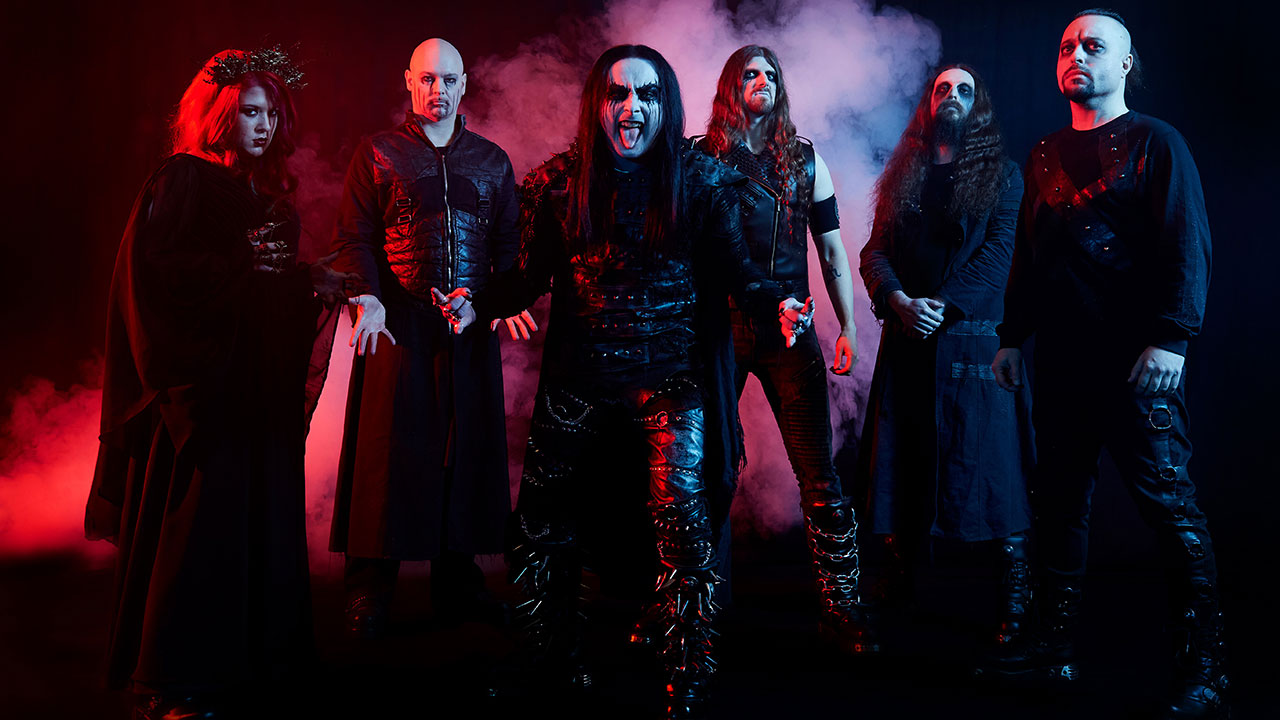East Anglia’s greatest shot at metal glory, Cradle Of Filth have been entertaining – and infuriating – us for 30 years now, and modern extreme metal would be a very different place without the prolific presence of Dani’s vampire circus. In Dani Filth they have one of metal’s most visionary frontmen, deftly weaving the darkest stories with wicked humour and florid ingenuity, belting them out in a demonic array of vocal spasms.
With just about the most distinctive aesthetic identity of any band of their era, it’s inevitable that such a forcefully eccentric entity has attracted as much hate as love over the decades. But there is plenty to love on all these albums – and only full-length studio releases are eligible, no EPs (sorry, Vempire lovers) – altogether representing a phenomenal, singular and assured body of work. So settle back on your catafalque for a moonlit flit through Cradle’s unlucky 13…

13. Thornography (Roadrunner, 2006)
Thornography is a thorny one. In a way, it’s the closest Cradle has to a ‘black album’; the unabashed attempts to widen the band’s appeal, the contentious over-correction towards slick simplicity and surface gloss, weighed against all the mighty, meaty hooks to make the dead headbang. It’s an album Cradle had to make, creating a full-on stadium-gothcore pop-thrash hybrid for one last concerted attack on the mainstream, nakedly angling for radio play with Tonight In Flames and Ville Vallo collaboration The Byronic Man. There are riffs that Slayer would have rejected as too lunkheaded even for Diabolus In Musica, but it’s a lot of fun.
12. Damnation And A Day (Sony, 2003)
Newly signed to major label Epic, Cradle scaled up their sonic ambitions with the Budapest Film Orchestra and Choir, lending a dramatic sense of scale to the album’s magniloquent symphonic urges. A 77-minute deconstruction of Milton’s epic poem Paradise Lost, for all its grandiosity Damnation And A Day still manages to be defined by the crunch of the guitars, mixed by Anthrax axeman Rob Caggiano. Yet some indefinable spark of atmosphere was missing, the bloated runtime and exhaustive narration testing the most loyal listener’s patience, even if the strongest songs – including Top 40 smash Babalon AD (So Glad For The Madness) – unusually arrive in the last third.
11. The Manticore And Other Horrors (Peaceville, 2012)
By 2012, Cradle’s hyperactive revolving door had jammed. Unprecedentedly, the band were functioning as a three-piece, so it’s little surprise that The Manticore And Other Horrors comes over as their most stringently stripped-down work, confirmed by its preponderance of punk and NWOBHM influences. Emphasising directness and simplicity doesn’t often get the best out of Cradle, even in this reduced form, with drummer Marthus doubling up on symphonic orchestration. Although frequently punchy and fun, it now feels rather dry and threadbare, Cradle employing a fairly undistinguished outside songwriter to help Paul Allender squeeze his inspiration dry on an LP that proved to be his last for the band – and significantly, their shortest.
10. Darkly, Darkly, Venus Aversa (Peaceville, 2010)
Cradle’s thematic pendulum swung back to the feminine with this florid concept album about the modern-day rebirth of mythological she-demon Lilith. Dani’s complex, witty lyrics are always among the band’s strongest suits, but his quill was in particularly delectable form – the potty poet laureate of metal in his element with this mordant, literary anti-heroine worship. There’s little wrong with Darkly, Darkly, Venus Aversa in truth, but apart from a few powerful exceptions – both singles are preposterously catchy, while the sludgy, haunting Persecution Song has a reflective staying power – much material is pretty stock Cradle, tending slightly towards safeness and over-familiarity.
9. Nymphetamine (Roadrunner, 2004)
Scoring a runaway success with the album’s special edition bonus track, the ravishing Nymphetamine Fix, the song’s sometime parent album was another overflowing mixed bag, Cradle re-embracing the lovelorn eyelashed goth melodies, showing their more sensitive side after the masculine focus of Damnation And A Day, while maintaining the rhythmic crunch and dropping in sly references to favourite 80s bands. Once you’re past the hilariously vituperative opening song Gilded Cunt it’s pretty family-friendly stuff, a perfectly charming string of elegant foot-tappers – until Cthulhu-driven closer Mother Of Abominations, the imperial blastbeats and lightning chords harking back to their violent black metal roots.
8. Godspeed On The Devil’s Thunder (Roadrunner, 2008)
Returning to the aristocratic medieval serial killer theme – this time the French nobleman and Satanic pervert Gilles de Rais – seemed to reawaken some of the epic vigour of Vempire-era 90s Cradle, tempos manically accelerated, energies focused on imperious cruelty in merciless blitzkriegs like Sweetest Maleficia and Midnight Shadows Crawl To Darken Counsel With Life. The one exception is the album’s runaway hit, The Death Of Love, a throbbing narrative doom ballad providing a powerful valediction for Cradle’s strongest female voice, Sarah Jezebel Deva. A modicum of filler doesn’t detract from the album’s consistent white-knuckle high drama – a baptism of fire for new skin-punisher Marthus.
7. Existence Is Futile (Nuclear Blast, 2021)
For their latest album – recorded in lockdown as a new pestilence stalked the globe and a compliant populace cowered in fear – the lads (and a new lass, singer/organist Annabel Iratni, who makes an instant impression with her imperious, plummy pronouncements) appropriately dive headlong into the end of the world. There’s no quarter given to vampires, witches or mythical antagonists of old; here the monster in the crosshairs is humanity, and this fevered, apocalyptic soundtrack dials down the orgiastic joie de vivre to create feasibly the angriest and saddest album Cradle have ever made – albeit with a wicked twinkle in its bloodshot eye.
6. Cryptoriana – The Seductiveness Of Decay (Nuclear Blast, 2017)
Confirming the ascendant strength of their latest line-up, Cradle returned to a psychogeography they know well, a death-obsessed Victorian Gothic milieu where the Gothicism isn’t all about swooning romantics in blood-stained frilly shirts, it’s also disease-ridden urchins, factory grime and the iniquities of Empire. Sparkling tunes like You Will Know The Lion By His Claw, Vengeful Spirit and the epic title track saw the developing Aschok/Shaw guitar interplay get ever wilder and more jubilant on Cryptoriana - The Seductiveness Of Decay, while Heartbreak And Séance, Wester Vespertine and Achingly Beautiful joyfully braided old and new strands of Filth with vigorous urgency, the ornate whole brimming with melodramatic dynamics.
5. The Principle Of Evil Made Flesh (Cacophonous, 1994)
Self-described on this album’s press release as “The Only True Black Metal Band in the UK,” on their debut LP this youthful corpsepainted sextet were giving the predominantly Norwegian style a decisively English twist, piling on the mordant eccentricity, Victorian libertinism and gothic Hammer Horror ambience to irresistible, far-reaching effect. It may seem primitive now, but The Principle Of Evil Made Flesh sounded daringly lavish at a time when black metal production was concertedly ugly and raw. The violent title track is still a setlist mainstay, but the pulsing dark romanticism of The Black Goddess Rises and The Forest Whispers My Name nailed the band’s distinctive MO right off the bat.
4. Hammer Of The Witches (Nuclear Blast, 2015)
Finally tackling the theme that was under their noses the whole time – the witch-burning history of their Suffolk homeland, old stomping ground of Matthew Hopkins, Witchfinder General – Cradle sounded ruggedly revitalised and bursting with purpose here, neat ideas fizzing off the grooves like sparks from a burning witch. Much of this is thanks to a peachy-keen new twin-guitar tag-team, Rich Shaw and Aschok, quickly bonded and locked in alchemical sync on some gorgeous, playful and incisive solos, melodies and harmonies. Ultimately, Hammer Of The Witches is a class act, nailing everything Cradle are best at with a true grandeur, more solemn and stately than ever.
3. Midian (Music for Nations , 2000)
Learning lessons from Cruelty And The Beast’s muddled production, the Clive Barker-inspired Midian was a rich, textured, high-gloss affair, rising to the challenge of the big league on an album that saw Cradle reaching the height of their mainstream infamy. Despite the intensifying brickbats from metal’s elitist gatekeepers, there was no ‘sell out’ here, Cradle easing off the flamboyant romanticism and vampire tropes to ramp up the heavy guitars and Lovecraftian horror. Mean, muscular anthems like Cthulhu Dawn and Lord Abortion kept the gritty fires blazing, while no Cradle concert this century has been complete without sprightly, melodic hit single Her Ghost In The Fog.
2. Cruelty And The Beast (Music for Nations, 1998)
Cradle’s first concept album told the story of metal’s favourite Hungarian countess, Elizabeth Bathory, smartly utilising the oratorical skills of scream queen Ingrid Pitt, who played the medieval murderess in 1970 Hammer horror Countess Dracula. Cruelty And The Beast was an instant classic, despite being stymied by flat, muddy production, controversial even within the band; singer Sarah Jezebel Deva recalls fleeing the playback in tears. “Most of us felt the album was ruined,” she wrote on a Cradle forum in 2007, adding “The songs are amazing but the mix was an outrage.” With 2019’s ‘Re-Mistressed’ version, the high-quality material finally had an appropriately elegant sonic wallop.
1. Dusk And Her Embrace (Music for Nations, 1996)
In 2016 Cradle released the original 1995 recording of this stone-cold-classic second LP, and the most remarkable revelation was discovering how much time, money and hard work were still needed to turn tentative, promising material into a glittering, seductive jet-black masterwork. Thin Lizzy/Magnum producer Kit Woolven gifted the band their grandest, most elegant production, while seductive, infectious anthems like A Gothic Romance, Funeral In Carpathia and the compulsive title track echo across the decades with flamboyant elan. Hoisting the band to hitherto unimaginable celebrity status, Dusk And Her Embrace remains the definitive Cradle artefact – especially in its coffin-shaped box edition, with their incendiary cover of Slayer’s Hell Awaits.
Cradle Of Filth's latest album, Existence Is Futile, is released on October 22 via Nuclear Blast

